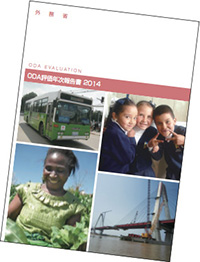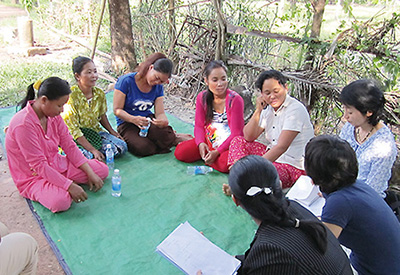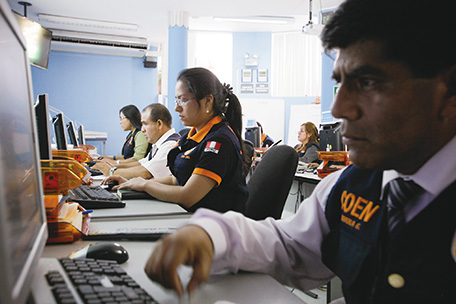ODA Topics 05
Highlights from the Annual Report on Japan’s ODA Evaluation 2014
– For Improving ODA through Evaluation
| Purpose of the Annual Report on Japan’s ODA Evaluation

“Annual Report on Japan’s ODA Evaluation 2014” introduces the summary of evaluations conducted in 2013. (Published by the Ministry of Foreign Affairs)
On the subject of ODA, the Ministry of Foreign Affairs (MOFA) annually publishes the Annual Report on Japan’s ODA Evaluation that provides an overview of ODA evaluation, in addition to the ODA White Paper. Since the release of the first Annual Report in 1982, it has been published 32 times as of this year.
Why does ODA have to be evaluated in the first place? Evaluations have two objectives: 1) To help improve Japan’s ODA management; and 2) To be accountable to the people of Japan for whether Japan’s ODA has been implemented appropriately.
To pursue the first objective, that is, to improve Japan’s ODA management, it is necessary to examine whether Japan’s ODA in different parts of the world has been implemented effectively and whether they are contributing to the development of the respective recipient countries. If room for improvement is identified, it will have to be duly addressed and reflected in Japan’s future ODA activities. For this purpose, MOFA annually selects around eight ODA topics on the basis of such factors as the priority themes and sectors of Japan’s development policy as well as the countries where Japan has implemented many ODA projects, and entrusts external experts to conduct third-party evaluations. The results of these evaluation studies and corresponding recommendations for future improvements of Japan’s ODA activities are published in the form of evaluation reports.
MOFA then publishes an annual report in pursuit of the second objective of ODA evaluation, which is to secure public support and understanding of Japan’s ODA. The annual ODA Evaluation Report contains the results of ODA evaluations conducted during the past year, as well as a brief description of how the Government responded to past recommendations by external experts.
Based on the idea that evaluations should be carried out from an objective standpoint, the third-party ODA evaluations and the annual ODA Evaluation Report are managed and prepared by a section that is independent from the section in charge of ODA and designated specially for ODA evaluation in MOFA.

Gathering all kinds of opinions from the farmers participating in the “Project on Gender Mainstreaming” in Kampong Cham Province in Cambodia.
| Outline of the Annual Report on Japan’s ODA Evaluation 2014

The National Emergency Operations Center in Peru. It is responsible for detecting disasters such as earthquakes and issuing warnings across Peru. (Photo: Kosuke Okahara / JICA)
The Annual Report on Japan’s ODA Evaluation 2014 is composed of three chapters and a reference section.
Chapter 1 gives an overview of the ODA evaluation system and its background. Chapter 2 presents an overview of the third-party evaluation results and their recommendations that MOFA conducted in 2013, and explains the measures taken by MOFA and JICA in response to these recommendations. Chapter 2 also contains an outline of ODA evaluations conducted by government ministries other than MOFA and by JICA, as ODA evaluations conducted by the Government of Japan are not limited to the ones managed by MOFA. One of the eight topics that were evaluated by external experts in FY 2013 was the Assistance under the Initiative for Disaster Risk Reduction, as is described below.
The Initiative was selected as one of the subjects of ODA evaluation studies considering that it was approaching an important milestone for evaluation. Firstly, 2015 would mark the 10th anniversary of the adoption of the Hyogo Framework for Action 2005-2015 as an international guideline for disaster risk reduction at the Second UN World Conference on Disaster Reduction in Kobe, as well as of the public launch of the Initiative for Disaster Risk Reduction as the basic guideline of Japan’s ODA activities in the area of disaster risk reduction. Secondly, the successor initiative to the “Hyogo Framework” was to be adopted in the near-term at the Third UN World Conference on Disaster Risk Reduction to be convened in 2015. It was thus considered that the evaluation of the Initiative, which had guided Japan’s assistance in the field of disaster risk reduction since its launch at the Second UN World Conference on Disaster Reduction, would provide a useful input to the Japanese Government’s policy making efforts towards the upcoming World Conference.
The evaluation concluded that the Initiative served the purpose of demonstrating to the Japanese people as well as to the international community Japan’s cooperation in the field of disaster risk reduction, which the Government of Japan had been pursuing for years. The recommendations for Japan’s future activities in this field contained such measures as the compilation of disaster-related statistics from disaster-prone countries and the introduction of a disaster risk evaluation system, which were expected to contribute to the mainstreaming of disaster risk reduction to be reflected in all aspects of development cooperation policy. The results of the evaluation and the recommendations are reflected in the current consideration within the Government of Japan on its future policies and activities in the field of disaster risk reduction in the run-up to the Third UN World Conference on Disaster Risk Reduction. (See ODA Topics).
Chapter 3 reports on the status of the follow-up measures of the eight ODA evaluation studies conducted in FY 2012.
For example, in the evaluation of Japan’s assistance to Cuba, the evaluation team recommended “cooperation that backs up Japan’s private sector’s activities” and “enhancement of Japan’s ODA implementation structure.” The 2014 Annual Report explains that, as a follow-up to these recommendations, the Government of Japan decided in October 2013 to send advisers to Cuba with expertise in the field of public-private partnership and in agricultural development, and that, in April 2014, JICA actually started the dispatch of two experts to the country, one for each of the two recommended areas of expertise. In the case of the evaluation of ODA’s contribution to gender equality and women’s empowerment, it was concluded that “Japan’s ODA projects should be examined from a gender perspective at all phases, including the request and planning phases.” The Annual Report states that JICA responded to this recommendation by asking recipient countries for cooperation in this regard and by introducing a new biannual monitoring system, while continuing to verify the adequateness of each project from a gender perspective at their early stages of formulation, including their request and planning phases, and to provide advice to recipient countries accordingly.
Reports of each evaluation and the Annual Reports are available to the public on the MOFA website. For further information, please visit the following link to the website:
http://www.mofa.go.jp/policy/oda/evaluation/index.html
*“Gender perspective” refers to a viewpoint that considers gender equality.
